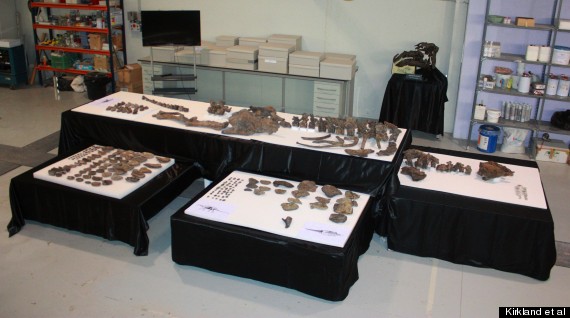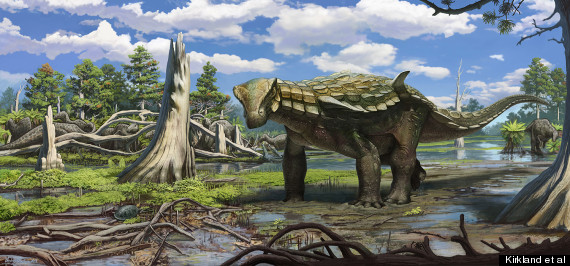Product Categories
Our newsletter
'Armored' Dinosaur Fossils Found In Spain Belong To Never-Before-Seen Species
'Armored' Dinosaur Fossils Found In Spain Belong To Never-Before-Seen Species, Scientists Say (PHOTOS)
A remarkable fossil find has led to the discovery of something quite unexpected: Not just a new species of dinosaur, but a whole new genus.
On Monday, researchers in Spain unveiled two armored dinosaur skeletons excavated from a coal mine in Teruel, a town in the northern part of the country. The specimens initially appeared to belong to a subspecies of armored dinosaur in the Ankylosauria group, but the researchers soon realized they were looking at something entirely different.
The scientists described their research in the peer-reviewed journal PLOS One, dubbing the previously unknown species Europelta carbonensis. One of the partial Europelta skeletons is displayed in Spain. (Image courtesy of James Kirkland et. al.)
One of the partial Europelta skeletons is displayed in Spain. (Image courtesy of James Kirkland et. al.)
Like other large lizardlike dinosaurs in the nodosauridae family, Europelta was a plant-eater and was covered in scaly dermal plates. But Europelta's unique features, such as a recurved back of the head and strongly arched pelvis, distinguish it from other nodosaurids.
A mural by Andrey Atuchin illustrates the Europelta carbonensis in its natural habitat. (Image courtesy of James Kirkland et al)
Researchers estimate that Europelta was at least 15 feet long, weighed about two tons, and thrived between 113 million and 110 million years ago during the Cretaceous period, making it the oldest nodosaurid discovered in Europe.
Before the nodosaurid ankylosaurs, their ancestors -- polacanthid ankylosaurs -- were the main armored dinosaurs in both Europe and North America until they became extinct around 118 million years ago. It was shortly after that time that nodosaurids appeared on both continents.
Yet it seems the European nodosaurids differed slightly from those in North America.
"The biggest point of significance is that, where the very spiny polacanthid ankylosaurs are the main armored dinosaurs in the both Europe and North America until about 118 million years ago, by 113 million years ago nodosaurid ankylosaurs have completely replaced them on both continents, yet are represented by distinctly different subfamilies on both continents," paleontologist Dr. James Kirkland, of the Utah Geological Survey, told The Huffington Post in an email.
What does this have to do with the new discovery? Since Europelta is closely related to other nodosaurs in Europe that thrived after it went extinct, the new finding suggests that Europe had become isolated from North America around 110 million years ago. If true, that suggests the widely held belief that the separation took place about 80 million years ago may be a bit off.- 2013-12-06
Related news



